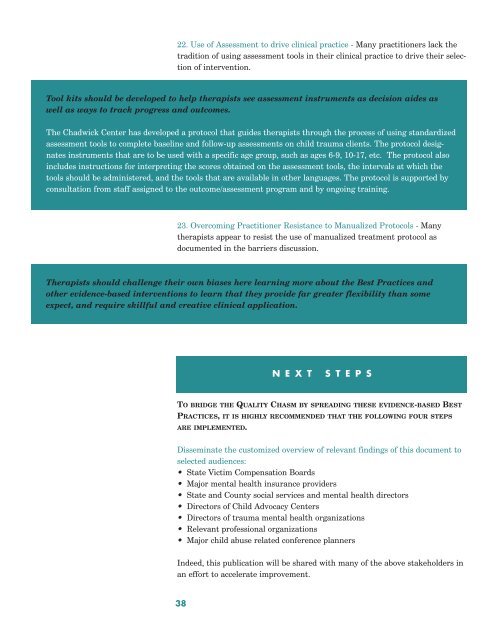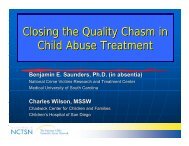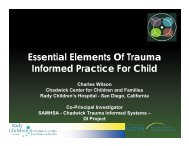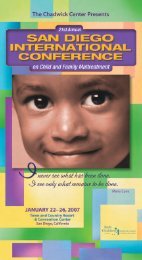Kauffman Best Practices Project Final Report - The Chadwick Center ...
Kauffman Best Practices Project Final Report - The Chadwick Center ...
Kauffman Best Practices Project Final Report - The Chadwick Center ...
Create successful ePaper yourself
Turn your PDF publications into a flip-book with our unique Google optimized e-Paper software.
22. Use of Assessment to drive clinical practice - Many practitioners lack the<br />
tradition of using assessment tools in their clinical practice to drive their selection<br />
of intervention.<br />
Tool kits should be developed to help therapists see assessment instruments as decision aides as<br />
well as ways to track progress and outcomes.<br />
<strong>The</strong> <strong>Chadwick</strong> <strong>Center</strong> has developed a protocol that guides therapists through the process of using standardized<br />
assessment tools to complete baseline and follow-up assessments on child trauma clients. <strong>The</strong> protocol designates<br />
instruments that are to be used with a specific age group, such as ages 6-9, 10-17, etc. <strong>The</strong> protocol also<br />
includes instructions for interpreting the scores obtained on the assessment tools, the intervals at which the<br />
tools should be administered, and the tools that are available in other languages. <strong>The</strong> protocol is supported by<br />
consultation from staff assigned to the outcome/assessment program and by ongoing training.<br />
23. Overcoming Practitioner Resistance to Manualized Protocols - Many<br />
therapists appear to resist the use of manualized treatment protocol as<br />
documented in the barriers discussion.<br />
<strong>The</strong>rapists should challenge their own biases here learning more about the <strong>Best</strong> <strong>Practices</strong> and<br />
other evidence-based interventions to learn that they provide far greater flexibility than some<br />
expect, and require skillful and creative clinical application.<br />
N E X T S T E P S<br />
TO BRIDGE THE QUALITY CHASM BY SPREADING THESE EVIDENCE-BASED BEST<br />
PRACTICES, IT IS HIGHLY RECOMMENDED THAT THE FOLLOWING FOUR STEPS<br />
ARE IMPLEMENTED.<br />
Disseminate the customized overview of relevant findings of this document to<br />
selected audiences:<br />
• State Victim Compensation Boards<br />
• Major mental health insurance providers<br />
• State and County social services and mental health directors<br />
• Directors of Child Advocacy <strong>Center</strong>s<br />
• Directors of trauma mental health organizations<br />
• Relevant professional organizations<br />
• Major child abuse related conference planners<br />
Indeed, this publication will be shared with many of the above stakeholders in<br />
an effort to accelerate improvement.<br />
38






